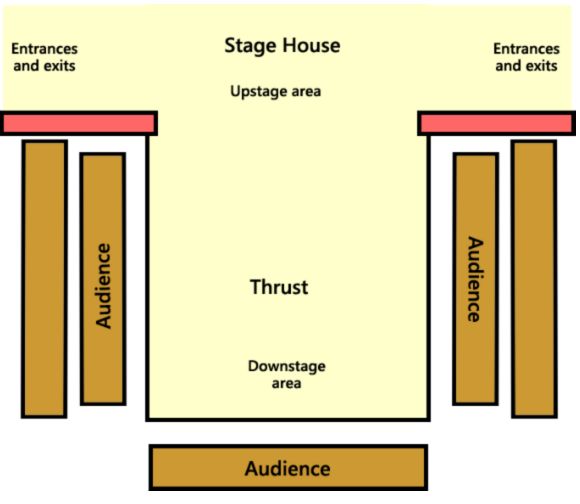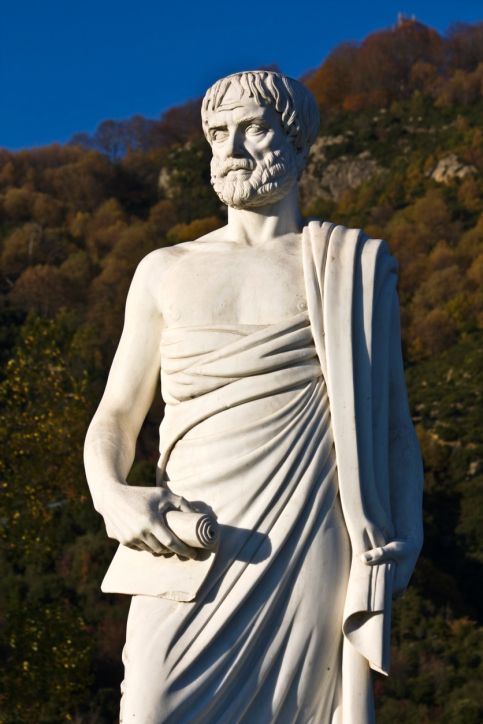Learn
Theatre
Playwrights express their artistic ideas, interests, and beliefs through their own combination of dialogue, fine art, music, and dance to create a beautiful and delightful viewing experience.
The word theatre is often used to mean performance. Both plays and musicals are written to be performed by live actors on a stage before an audience as a form of entertainment.
The audience is a fundamental part of any performance. The presence of the audience sets theatre apart from other forms of entertainment, such as television and film, because this audience has its own personality. The personality is shown through shouts, cheers, boos, laughs, standing ovations, and overall response that affects the performers and makes each and every performance completely original.
Stages
The physical environment of a theatrical production is an important aspect of the presentation. Various factors, such as whether the theatre space is small or large, indoors or outdoors, formal or informal, and the shape of the stage and proximity to the audience all work together to create a unique viewing experience for the audience. In fact, the first impression that a viewer has is of the actual theatre space itself. The atmosphere of the theatre building has a great deal to do with the mood of the audience, their expectations of the event, and their response to the performance.
There are various forms and styles of theatre buildings, including the arrangements of audience seating and stage shape. Throughout theatre history, there have been four basic types of stages, each with its own characteristics, advantages and disadvantages, each suited for different types of plays and productions in order to provide the audience with a slightly different experience.
There are five main types of stages.
1. Proscenium Stage

Since the Italian Renaissance, the most common stage has been the proscenium stage.
A proscenium stage is also known as a picture frame stage. The primary feature of the proscenium stage is the proscenium arch through which the audience views the performance. The proscenium arch's name evolved from the "proscenium" in Ancient Greek theatres, which was the space in front of the "skene," or backdrop where the actors actually performed.
2. Arena Stage

Most ancient theatres were arranged this way.
An arena stage is also known as theatre-in-the-round. This type of theatre is in the center of an auditorium with the audience seated on all sides. There are no boundary lines which separate the performers from the audience.
Actors entered and exited through the same aisles.
The set design is often minimal so that the audience's view of the performance is not obstructed.
3. Thrust Stage

The thrust stage is without a proscenium.
The thrust stage is also known as a platform stage or an open stage because it extends into the audience. The audience surrounds the stage on three sides. The fourth side functions as the background.
4. Created Spaces
A created or found space stage is improvised and made where ever a suitable space can be found. For example, a created stage could be found on the side of a hill, a street corner, a basement, or the middle of a room.
Stages can be created by changing the environment in which it is placed.
5. Black Box
A black box theatre is also known as an all-purpose theatre because it uses a simple, non-decorative performance space. It is typically a large room with black walls and a flat floor. The stage and seating are not fixed, so they can be altered if needed.
Tragedy
Originated in ancient Greece and claiming the title as the very first genre of theatre in existence, the tragedy genre has been studied and criticized by thousands of writers and viewers for centuries.
According to Aristotle, the truly defining characteristic of tragedy is the emotion that it produces in the audience - one of "pity and fear" - pity for the main character (who we all come to like usually), and fear for ourselves (because we know that we could easily make the same mistakes he/she does). It is this emotion that separates tragedy from all other theatre genres, and it is this emotion that has caused this particular genre of theatre to still be considered one of the greatest art forms of all times.
According to Aristotle, the tragedy genre generally centers around the tragic protagonist, generally a high-ranking person, such as a nobleman or king who is essentially a good person and one with whom the audience identifies.

This is a statue of the philosopher Aristotle.
During the course of the tragedy, the protagonist is brought from happiness to misery through the loss of status, loved ones, or the character's own life. These losses are usually the result of personal weakness or misjudgments referred to as tragic flaws. Through this suffering, the protagonist usually discovers a sense of awareness of truth, self, love, or others.
Comedy
Comedy is a genre of theatre that is in direct contrast to tragedy. Comedy is simply everything that tragedy is not. The word comedy is derived from the Greek words komos and ode, meaning revel song.There are several defining characteristics that make up a classical comedy. Situations and conflicts such as mistaken identity, battle of the sexes, and jumping to conclusions are what set the comedic story apart from the tragedy. These are all situations that could occur at any time, any day, and to anyone.
Comedy is concerned with characters who are considered "every day," ordinary, somewhat "less-than-average;" the audience likes these characters because they can relate to them. They are more like us, and their lives and situations are lives and situations that mirror our own.
Within a comedy, no matter how much chaos and dismay may appear, the play usually ends with the classic, "And they all lived happily ever after," capturing the viewer with a sense of compassion and love for the characters in the story.
A primary difference between tragedies and comedies is the manner in which the conflict, or problem, is resolved. In a comedy, the protagonist overcomes conflicts and opposing forces and achieves the desired goal.
Other Types of Plays
There are other forms of drama besides tragedies and comedies.
A fantasy includes unreal characters, dreams, and imaginary times and places. Most fantasies have a basis in reality, but they are usually set in make-believe places and are often inhabited by beings or spirits with supernatural powers, gods from another world, witches, and / or flawless heroes. Examples of fantasy plays include the Wizard of Oz, Peter Pan, and A Midsummer Night's Dream just to name a few.
Watch a clip from the movie A Midsummer Night's Dream called Puck Uncovered (01:30). PBS login information.
Romantic comedies usually revolve around characters who are involved in love affairs. The characters are flawless heroes and virtuous heroines who are ideally suited for each other. Generally, their path to love has its ups and downs, but eventually, all ends happily. Examples of romantic comedies include Pitch Perfect, Tangled, and The Merchant of Venice.
Sentimental comedies are similar to romantic comedies, but sentimental comedies lack the humor needed to enjoy long-lived success. This type of comedy has been characterized as an emotional and ideal presentation of characters, a hero and heroine, who are so virtuous they seem unreal. The villains are so bad that they have no redeeming qualities.
Due to their lack of substance, flat characters, and contrived plots, sentimental comedies are not very popular.
The melodrama presents an old storyline in which an honorable heroine is threatened by a wicked villain, but is rescued by an immaculate hero. Melodrama presents a clear-cut view of morality where the good characters are always seeking the right, and the bad characters are always seeking the wrong. Similar to tragedy, the good characters usually suffer in some ways throughout the play; however, the good always triumphs in the end. Examples of popular melodramatic plays include Marley & Me, The Fault in Our Stars, and Gone with the Wind.
A play of ideas is sometimes referred to as a problem play or a social drama. This type of play deals with a social problem, such as racism or sexism, in which common ideas concerning right and wrong are questioned. The playwright generally presents a solution to the problem and attempts to guide the characters in the right direction toward solving the problem. Some famous examples include An Enemy of the People and A Raisin in the Sun.
View an excerpt of A Raisin in the Sun (05:37). (You can login or select 'Continue as Guest.') PBS login information.Psychological dramas are serious plays, often painful in which the playwright battles the complexities of the human psyche and personal relationships. Examples include The Glass Menagerie and Who's Afraid of Virginia Woolf.
A "whodunit" drama involves suspense where a crime has been committed and the plot of the play revolves around solving the crime. Some popular "whodunit" plays include Ten Little Indians and The Mousetrap.
A musical is a theatrical genre in which the story is told through the performance of singing with instrumental music, spoken dialogue, and often dance. Some well-known examples include The Sound of Music, Chicago, and Fiddler on the Roof.
You've probably heard of the hit musical Hamilton about one of America's founding father. To see some of the songs from this musical, watch 'Hamilton' the Musical Tells the Immigrant Story of a Founding Father | PBS NewsHour (8:42). PBS login information.